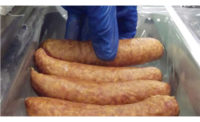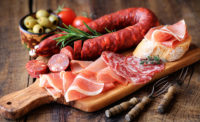Ingredients
Use of natural ingredients to extend shelf life of meat products
Natural extension to shelf life

Two major categories of shelf-life extending ingredients are to improve quality and safety of meat and poultry products. Focus on improving eating quality is primarily to reduce oxidative changes such as lipid oxidation, which can result in off-flavor development, says Ranjith Ramanathan, associate professor in the Department of Animal and Food Sciences at Oklahoma State University, in Stillwater. Several antimicrobials are added to increase shelf life by limiting the growth of spoilage and pathogenic organisms.
For the extension of meat shelf life, a trend toward natural plant extracts such as rosemary, green tea and acerola extract has occurred. These products have been around for several years but are gaining popularity, says Jerrad Legako, assistant professor in the Department of Animal and Food Sciences at Texas Tech University, in Lubbock, Texas. For plant extracts, varied antioxidant potency is present, which can aid in maintaining color and preventing off odors by slowing lipid oxidation.
Products such as buffered vinegar also have been demonstrated to be a popular shelf-life extender, Legako says. Buffered vinegar offers an antimicrobial benefit, which may extend shelf life by slowing growth of spoilage organisms.
Plant extracts and buffered vinegar products offer a certain level of effectiveness, Legako says. But one of the primary factors driving their use is consumer perception.
“It is generally understood that consumers seek out products and ingredients that are perceived to be naturally derived,” Legako says. “Therefore, ingredients with recognizable names and designation as ‘natural’ are more well received than synthetic ingredients with unfamiliar names.”
Ramanathan agrees that with the recent trend in clean labeling more consumer-friendly, shelf-life-extending ingredients are being added. For example, more vinegar-based antimicrobials are being used. Lactate or lactic acids are still used to limit microbial growth and improve quality as well. In addition, more natural antioxidants or flavoring agents are used instead of synthetic antioxidants, such as BHT (butylated hydroxytoluene) or BHA (beta hydroxy acid).
“Maybe in future, more active packaging with addition of antioxidants or antimicrobials may be used to improve shelf life,” Ramanathan says.
The stability of natural compounds can be challenge, though, especially with the use of natural antioxidants. “In future, use of non-thermal processes such as high-pressure processing may be more commonly used,” he says.
Process aids, such as peracetic acid, also are being used to meet clean labeling demands. “These compounds have antimicrobial activity at the same time they are unstable and will not leave any residues, and, hence, do not require labeling,” says Jacob Nelson, meat-processing specialist for the Robert M. Kerr Food and Agricultural Products Center at Oklahoma State University.
Formulating Challenges
Shelf-life extenders, such as the plant-derived antioxidants, have two primary challenges. First, plant-derived ingredients historically have contained antioxidant components and flavor-contributing compounds.
“It is very challenging to segregate the antioxidant-contributing compounds from the compounds that may impact odor and flavor,” Legako says.
As a result, some ingredients influence flavor. If the flavor is not desired, the ingredient would need to be modulated to reduce the impact on flavor, Legako explains. This is typically done by lowering the concentration in formulations; however, processors would need to maintain the efficacy of the ingredient and not lower the content beyond effectiveness.
“This creates a real product development scenario where an ideal formulation is sought after,” Legako explains. “That ideal formulation would extend shelf life, but not alter product flavor. To further overcome this issue, antioxidant suppliers continue to develop innovative extraction methods to further isolate the compounds beneficial to shelf life from the flavor compounds.”
Another challenge arises when a processor decides to switch shelf-life extenders.
“In a scenario where an existing product is being reformulated to use natural plant extracts, all of the issues above would apply,” Legako says. “However, of further interest in a transition is the cost difference. In general, so-called ‘clean-label’ ingredients cost more. Processers would then need to consider the formulation cost increase associated with transitioning from synthetic to natural shelf-life extenders.”
Nelson also says that cost of natural shelf-life ingredients can drive up the final price.
“Processors are using different ingredients to extend shelf life and gauge consumer response,” he adds. “Recently, more and more vacuum package brick-type packaging for ground beef is seen in store to improve shelf life.”
Consumer interest in meat and poultry products and their ingredients will continue going forward.
“Removing any vague wording on labels and communicating a product and ingredients that consumers perceive to be real and transparent will be targeted,” Legako says. “Additionally, any opportunity to make a labeling claim on the front of the package will drive what goes into formulations. Given multiple options, consumers tend to favor the options they perceive to be the right choice. Labeling claims may not always dictate this perception; however, it is generally believed that they do resonate positively with consumers.” NP
Looking for a reprint of this article?
From high-res PDFs to custom plaques, order your copy today!








